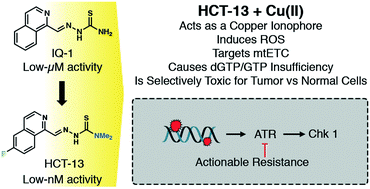Isoquinoline thiosemicarbazone displays potent anticancer activity with in vivo efficacy against aggressive leukemias†‡
Abstract
A potent class of isoquinoline-based α-N-heterocyclic carboxaldehyde thiosemicarbazone (HCT) compounds has been rediscovered; based upon this scaffold, three series of antiproliferative agents were synthesized through iterative rounds of methylation and fluorination modifications, with anticancer activities being potentiated by physiologically relevant levels of copper. The lead compound, HCT-13, was highly potent against a panel of pancreatic, small cell lung carcinoma, prostate cancer, and leukemia models, with IC50 values in the low-to-mid nanomolar range. Density functional theory (DFT) calculations showed that fluorination at the 6-position of HCT-13 was beneficial for ligand-copper complex formation, stability, and ease of metal-center reduction. Through a chemical genomics screen, we identify DNA damage response/replication stress response (DDR/RSR) pathways, specifically those mediated by ataxia-telangiectasia and Rad3-related protein kinase (ATR), as potential compensatory mechanism(s) of action following HCT-13 treatment. We further show that the cytotoxicity of HCT-13 is copper-dependent, that it promotes mitochondrial electron transport chain (mtETC) dysfunction, induces production of reactive oxygen species (ROS), and selectively depletes guanosine nucleotide pools. Lastly, we identify metabolic hallmarks for therapeutic target stratification and demonstrate the in vivo efficacy of HCT-13 against aggressive models of acute leukemias in mice.



 Please wait while we load your content...
Please wait while we load your content...